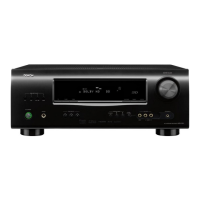13
ENGLISH
Advanced versionSimple version InformationBasic version
Connecting to a device equipped with a DVI-D connector
When an HDMI/DVI conversion cable (sold separately) is used, the HDMI video signals are converted to
DVI signals, allowing connection to a device equipped with a DVI-D connector.
NOTE
• No sound is output when connected to a device equipped with a DVI-D connector. Make separate audio
connections.
• Signals cannot be output to DVI-D devices that do not support HDCP.
• Depending on the combination of devices, the video signals may not be output.
n Settings related to HDMI connections
Set as necessary. For details, see the respective reference pages.
Other Setup (vpage36)
Make settings for HDMI audio output.
• Audio Out
NOTE
The audio signals output from the HDMI connectors are only the HDMI input signals.
Connecting an HDMI-compatible device
Connecting a TV
• Select the connector to use and connect the device.
• For instructions on HDMI connections, see “Connecting an HDMI-compatible device” (vpage12).
To listen to TV audio through this device, use the optical digital connection.
NOTE
• If the VIDEO input connector and S-VIDEO input connector are to be used, be sure to connect the
MONITOR output connector of the unit and the VIDEO input connector of the TV, using a video cable.
• If the COMPONENT VIDEO input connectors are to be used, be sure to connect the COMPONENT
MONITOR output connectors of the unit and the COMPONENT VIDEO input connectors of the TV, using
a component video cable.
Cables used for connections
Video cables (sold separately)
Video cable
(Yellow)
Component video
cable
(Green)
(Blue)
(Red)
Audio cable (sold separately)
Optical cable
*/
7*%&0
7*%&0
"6%*0
015*$"-
065
$0.10/&/57*%&0
:1# 13
*/
TV
Set this to change the digital input connector or component video input connector to which the input
source is assigned.
“Input Assign” (vpage33)
in Set as Necessary
1.AVR1311E2ENG3rd100617.inddSec:131.AVR1311E2ENG3rd100617.inddSec:13 2010/06/1718:24:122010/06/1718:24:12

